Everyone learned some important “herstory” about British women in World War 1 on Mon 26 Feb. Soroptimist International St Albans and District were delighted to welcome Alex Amos to speak about “The Formation and Organisation of the Women’s Land Army in WW1” – this is of particular interest to Soroptimists because the organisation was founded in 1921, soon after WW1. The Women’s Land Army changed British women’s lives forever, and was vital for the outcome of the war.
Members of SI St Albans and District were joined by friends of Members and guests from Soroptimist Clubs as far afield as Bridgend and Lincoln – technology is a gift for connecting people.
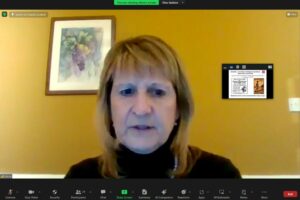 Diana Kingham introduced guest speaker Alex Amos who is a researcher with the Luton Hoo Walled Garden Volunteer Project – where Diana is also a volunteer. Alex is pictured here on the Zoom call.
Diana Kingham introduced guest speaker Alex Amos who is a researcher with the Luton Hoo Walled Garden Volunteer Project – where Diana is also a volunteer. Alex is pictured here on the Zoom call.
We can’t publish Alex’s presentation materials on the website because some of it may be subject to copyright law for online publishing, but if you’d like to receive a copy please email sistalbans@hotmail.com.
By 1914 the idea of women working on the land was degrading. Women wanted to better themselves and were getting educated and leaving working on the land. An Essex newspaper on 1st August 1914 reported, ‘The wives and mothers should be in their own homes looking after the food and drink side of the men’s life during this laborious season and paying increased not diminished attention to the bodily requirement of their husbands and sons’.
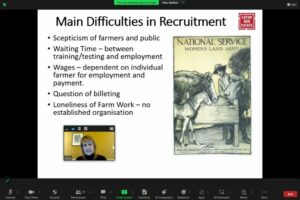 In WW1 it was very difficult to recruit women for the farm work. Wages varied depending on the farmer. They were meant to be paid a set rate of 20 shillings but this wasn’t enforced so down to the farmer. Loneliness was an issue for the women.
In WW1 it was very difficult to recruit women for the farm work. Wages varied depending on the farmer. They were meant to be paid a set rate of 20 shillings but this wasn’t enforced so down to the farmer. Loneliness was an issue for the women.
In 1915 training was introduced. The women trained for around 4 weeks, learning to milk cows, sometimes training on fake cows!
In 1916 100,000 men were called up to fight so recruitment of women to work the land was imperative.
Competitions were set up to encourage women to sign up. The competitions were on subjects such as milking, driving stock, weeding. 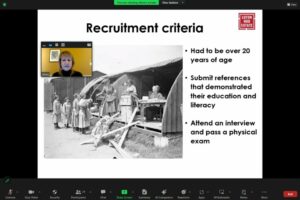 Advertising was put in cinemas, magazines. Certificates were introduced and this acted as a turning point as women were getting recognition for their role in the war: “Every woman who helps in agriculture during the war is truly serving her country just as the man who is fighting in the trenches or on sea’”. A uniform was introduced but the uniform was voluntary and women were expected to pay for it themselves. Many women were unable to pay for the uniform.
Advertising was put in cinemas, magazines. Certificates were introduced and this acted as a turning point as women were getting recognition for their role in the war: “Every woman who helps in agriculture during the war is truly serving her country just as the man who is fighting in the trenches or on sea’”. A uniform was introduced but the uniform was voluntary and women were expected to pay for it themselves. Many women were unable to pay for the uniform.
There was a Women’s Land Army song to motivate the women – Alex played it to us, if you click on this web page there is a link for you to play and listen too: https://virtual-library.culturalservices.net/webingres/bedfordshire/vlib/0.wla/wla_bedfordshire_land_army_song.htm
First world war British recruiting poster for Women’s Land Army. British Government.Some men were exempt if they were in protected occupations such as farm workers. Once the women were trained up the women could take up these roles allowing the men to be called up.
In 1917 the Defence of the Realm Act (DORA) was introduced. DORA enabled the government to take over 2.5 million acres of agricultural land. A grant of 10s per week was offered to farmers. 247 Training centres and 140 training farms were setup throughout the country
Lady Wernher at Luton Hoo donated estate land for farmland. All women had to be over 20 years of age, pass a physical exam and provide references. They signed up for 6 month and 1 year contracts. They also had to pass an efficiency test. Once these requirements were met the uniforms were provided free and the wage was agreed. Women recruits received contracts and handbook. Women were told that their role was just as important as men in the war effort. This boosted morale and recruitment.
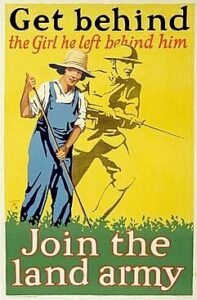
The WLA Handbook required that every recruit promise:
- To behave quietly
- To respect the uniform and make it respected
- To secure eight hours sleep every night
- To avoid communication of any sort with German prisoners
In 1917 a uniform was set and made free to the women. Decorations were also added including a service arm let and 6 months stripes were provided. If they recruited 5 new members they were given ribbons which could be worn on their hats.
In 1917 the Women’s Forestry Corps was formed – responsible for the supply of wood for industry and paper production. It had two sections: Measurers & Cutters – Skilled. Measuring and cutting trees, and Fellers – Physical. Sawing and handling of horses to drag trees.
1917 the Women’s Forage Corps recruited 8,000 members. They were based at army camps and looked after the horses and involved in the supply and production of hay.
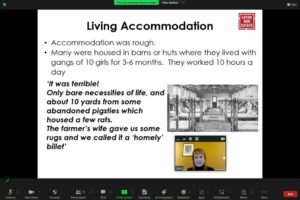 Accommodation was rough. Many were housed in barns or huts where they lived with gangs of 10 girls for 3-6 months. They worked 10 hours a day. Later on standards were introduced to improve living conditions.
Accommodation was rough. Many were housed in barns or huts where they lived with gangs of 10 girls for 3-6 months. They worked 10 hours a day. Later on standards were introduced to improve living conditions.
Lady Wernher lent Cooter’s End, on the Luton Hoo estate as a training centre and hostel.
- 16 girls were trained in milking and horse work.
- 3 girls were trained to plough the fields
- 7 girls attended thatching classes.
James Baker (Estate Agent for Lady Wernher) arranged the farmers on the estate to take on a number of girls. His wife organised housekeeping matters for 50+ girls.
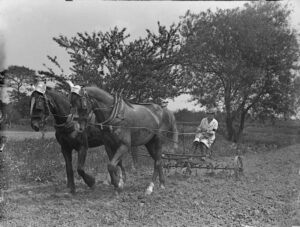
In 1917 Efficiency Tests for Land Girls had begun nationally, with examiners selected from the areas where the training centres were held. In Bedfordshire tests included horse work, ploughing, thatching, care of stock and milking. Cooter’s End training centre near Luton Hoo, is one of the places where Efficiency Tests were held. Women got an extra 2 shillings for each efficiency test passed.
1918 the majority of girls trained at Luton Hoo received a Grade A on Efficiency tests. Along with test results they would get a report. Boredom and loneliness was an issue. After working shifts the girls would go out and socialise. This was not approved of as girls would cut their hair, shorten breeches. The Landswoman was created as a magazine and companion for the women. The hope was to bind the women together into a big family. It included sewing, knitting and correspondence clubs. Also quizzes and crossword puzzles which provided some occupation.
Lot of propaganda was used to attract women. They needed more recruits in 1918 and they had a big advertisement campaign which was successful. About 400 women recruited ready for training.
Recruitment drives took place with demonstrations to show what the girls could achieve and learn. One took place as late as 1st June 1918.
In 1919 WLA was disbanded as men returned home and imports resumed.The Agricultural Policy in Britain was a success by comparison to Europe. Lloyd George would go further stating in his memoirs:
“The food question ultimately decided the issue of the war”.
As always there were plenty of questions for Alex after her presentation.
Q: Did the women look after themselves? A: In Luton Hoo women stayed in nearby accommodation such as the girls school and they would have someone to cook for them. The food was very basic. They took care of everything else.
Q: Who originally set up the land girls? A: It’s not clear but the government got involved during WW1.
Barbara shared that the minister of agriculture may have been involved as they played a role in the WI set up.
Q: was their conscription? A: Sign up was voluntary but there was pressure put on them as the movement became more organised and women were encouraged to ‘do their bit’. Calling them an army that gave the women the recognition that boosted things.
Helen shared how important it was for volunteers like Alex to keep researching and telling the “herstory” of women.
A guest attending shared the experience of her mother and developing her skills in catering. It was possible that this was preparation for another possible war.
Alex added that Lady Wernher lost one of her sons during the war and this got her involved in support for those who were disabled during the war.
Alex shared the parallels between the Women’s Land Army and Soroptimists in their role in improving the conditions of women.
Diana Kingham gave the vote of thanks and said how the presentation had helped us to relate to the lives of the Land Army women. Everyone who attended applauded on their Zoom screen and thanked Alex for a really enlightening evening.
There is no pressure to make a donation but any will be welcomed by the Luton Hoo Walled Garden Volunteer Project – please click here for more information https://lutonhooestate.co.uk/the-walled-garden/ and email sistalbans@hotmail.com to be sent the details for making a bank transfer.
Background for the talk:
During WW1, 23,000 women were employed by the Women’s Land Army to work full time on the land, taking on the vital jobs in agriculture, forage production and timber cutting necessary to keep the country functioning while the men were away at war.
Alex traces the development of the Women’s Land Army, illustrated by references to the women who lived and worked on the Luton Hoo Estate and farms. This form of national service was a tough life for the young women who were recruited from a variety of backgrounds.
The Women’s Land Army was reformed during WW2 and again played a vital role in food production at Luton Hoo and in the rest of the country.
Alex’s talk is a celebration of the capabilities and hard work of this group of women.
‘The objective was simple: ‘to procure, train and equip a large number of women able and willing to devote their time to agricultural work wherever they are required’. Board of Agriculture
Alex Amos is a researcher with the Luton Hoo Walled Garden Volunteer Project. The Land Army is just one of the research projects carried out by the team.

